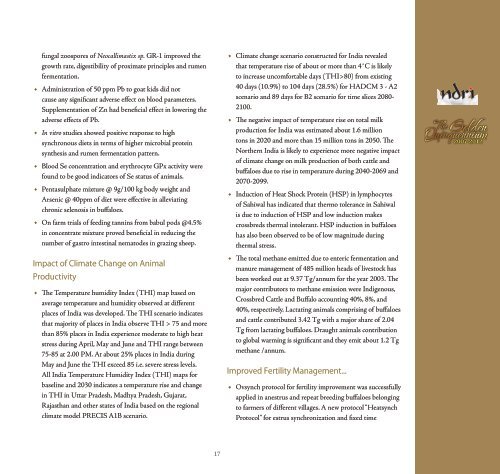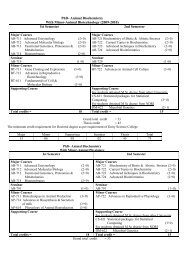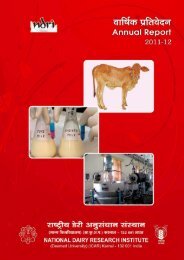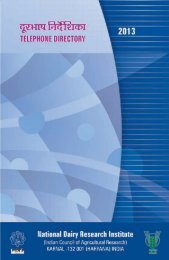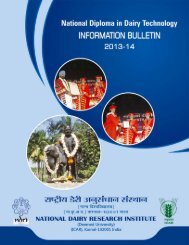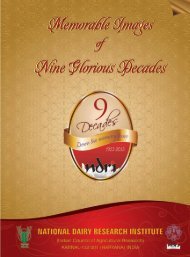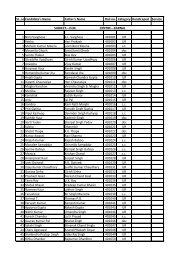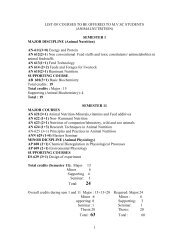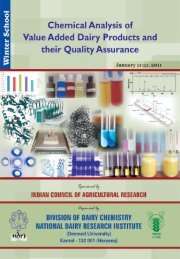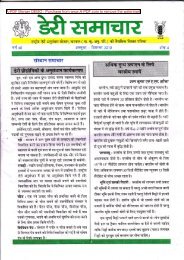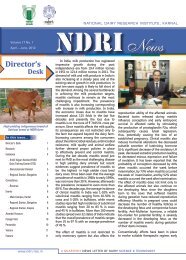NDRI Quinquennium Book COVER FINAL CURVE.cdr
NDRI Quinquennium Book COVER FINAL CURVE.cdr
NDRI Quinquennium Book COVER FINAL CURVE.cdr
Create successful ePaper yourself
Turn your PDF publications into a flip-book with our unique Google optimized e-Paper software.
fungal zoospores of Neocallimastix sp. GR-1 improved thegrowth rate, digestibility of proximate principles and rumenfermentation.••Administration of 50 ppm Pb to goat kids did notcause any significant adverse effect on blood parameters.Supplementation of Zn had beneficial effect in lowering theadverse effects of Pb.••In vitro studies showed positive response to highsynchronous diets in terms of higher microbial proteinsynthesis and rumen fermentation pattern.••Blood Se concentration and erythrocyte GPx activity werefound to be good indicators of Se status of animals.••Pentasulphate mixture @ 9g/100 kg body weight andArsenic @ 40ppm of diet were effective in alleviatingchronic selenosis in buffaloes.••On farm trials of feeding tannins from babul pods @4.5%in concentrate mixture proved beneficial in reducing thenumber of gastro intestinal nematodes in grazing sheep.Impact of Climate Change on AnimalProductivity••The Temperature humidity Index (THI) map based onaverage temperature and humidity observed at differentplaces of India was developed. The THI scenario indicatesthat majority of places in India observe THI > 75 and morethan 85% places in India experience moderate to high heatstress during April, May and June and THI range between75-85 at 2.00 PM. At about 25% places in India duringMay and June the THI exceed 85 i.e. severe stress levels.All India Temperature Humidity Index (THI) maps forbaseline and 2030 indicates a temperature rise and changein THI in Uttar Pradesh, Madhya Pradesh, Gujarat,Rajasthan and other states of India based on the regionalclimate model PRECIS A1B scenario.••Climate change scenario constructed for India revealedthat temperature rise of about or more than 4˚C is likelyto increase uncomfortable days (THI>80) from existing40 days (10.9%) to 104 days (28.5%) for HADCM 3 - A2scenario and 89 days for B2 scenario for time slices 2080-2100.••The negative impact of temperature rise on total milkproduction for India was estimated about 1.6 milliontons in 2020 and more than 15 million tons in 2050. TheNorthern India is likely to experience more negative impactof climate change on milk production of both cattle andbuffaloes due to rise in temperature during 2040-2069 and2070-2099.••Induction of Heat Shock Protein (HSP) in lymphocytesof Sahiwal has indicated that thermo tolerance in Sahiwalis due to induction of HSP and low induction makescrossbreds thermal intolerant. HSP induction in buffaloeshas also been observed to be of low magnitude duringthermal stress.••The total methane emitted due to enteric fermentation andmanure management of 485 million heads of livestock hasbeen worked out at 9.37 Tg/annum for the year 2003. Themajor contributors to methane emission were Indigenous,Crossbred Cattle and Buffalo accounting 40%, 8%, and40%, respectively. Lactating animals comprising of buffaloesand cattle contributed 3.42 Tg with a major share of 2.04Tg from lactating buffaloes. Draught animals contributionto global warming is significant and they emit about 1.2 Tgmethane /annum.Improved Fertility Management...• • Ovsynch protocol for fertility improvement was successfullyapplied in anestrus and repeat breeding buffaloes belongingto farmers of different villages. A new protocol “HeatsynchProtocol” for estrus synchronization and fixed timeThe<strong>Quinquennium</strong> Golden2007-201217


